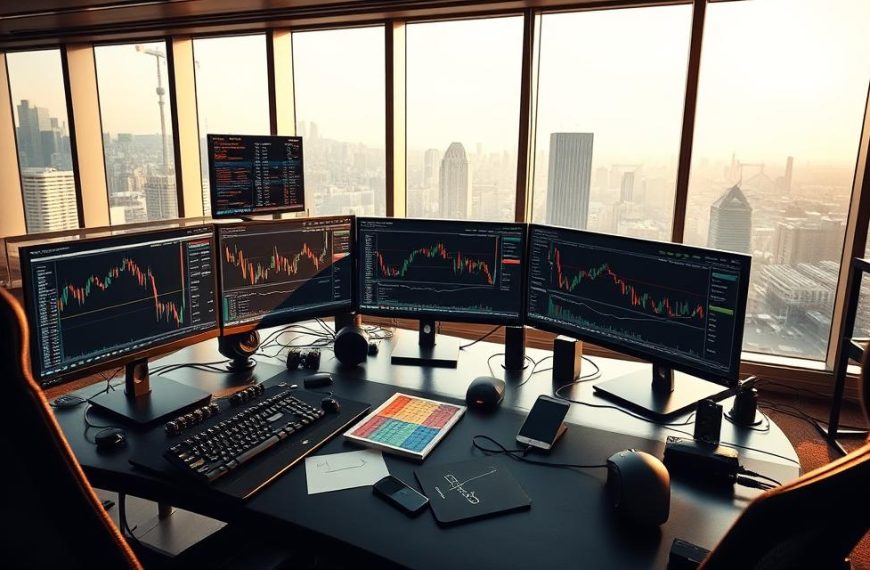Digital asset markets have undergone a seismic shift in recent years. Sophisticated tools powered by machine learning now offer traders unprecedented capabilities, transforming how they interact with volatile markets. These systems analyse vast datasets in real time, identifying patterns human eyes might miss.
Modern solutions address longstanding challenges in asset exchanges. Emotional decision-making and timing errors – common pitfalls for investors – are mitigated through intelligent automation. Both newcomers and seasoned professionals benefit from access to institutional-grade strategies previously locked behind paywalls.
The UK’s financial landscape has embraced this evolution enthusiastically. British investors increasingly rely on algorithmic systems to optimise portfolios and manage risk. Continuous operation across global exchanges gives these tools a distinct edge over manual approaches.
This technological leap doesn’t just streamline processes – it redefines competition. Retail traders now wield analytical firepower rivalling hedge funds. Market dynamics shift as data-driven decisions replace gut instincts, creating a more level playing field.
As adoption grows, these innovations continue to evolve. New features emerge regularly, offering enhanced predictive capabilities and customisation options. The future of digital asset management appears increasingly automated, precise, and accessible.
Understanding Crypto AI Platforms
Modern trading environments now leverage cutting-edge technology to empower users. These solutions combine predictive analytics with self-improving algorithms, creating dynamic strategies that adapt to market shifts. By processing billions of data points across exchanges, they uncover hidden opportunities in milliseconds.
What Powers Modern Trading Solutions?
Sophisticated systems analyse market trends using machine learning, executing trades based on real-time signals. Unlike manual methods, they operate continuously – monitoring price movements, liquidity shifts, and social sentiment simultaneously. This constant vigilance helps identify emerging tokens before major price surges occur.
Essential Benefits for Investors
Three critical advantages redefine how people engage with digital assets:
- Emotion-free execution: Algorithms follow predefined rules, avoiding impulsive decisions during market swings
- Round-the-clock precision: Automated processes track global exchanges without downtime or fatigue
- Institutional-grade access: Retail investors now utilise strategies once exclusive to hedge funds
Curated token baskets simplify portfolio diversification, allowing single-click exposure to top-performing sectors. Integrated assistants provide instant answers to strategy questions, while backtesting features validate approaches against historical data. As these tools evolve, they continually refine their predictive accuracy through accumulated market experience.
The Evolution and Impact on Trading Practices
Market participation strategies have transformed radically through technological innovation. Advanced systems now process complex datasets faster than any human operator, reshaping decision-making processes across exchanges.
From Manual to Automated Trading
Traditional methods demanded constant screen time and ironclad discipline. Even skilled traders often missed opportunities during sleep cycles or emotional spikes. Automated execution resolves these issues through predefined rules that operate 24/7.
Modern solutions remove psychological hurdles like panic selling. They analyse historical patterns to avoid repeating costly mistakes. This shift has particularly benefited UK investors managing multiple asset classes across time zones.
Leveraging AI for Real-Time Market Analysis
Contemporary tools scan news feeds, price charts, and social chatter simultaneously. They detect subtle correlations between seemingly unrelated events – like regulatory announcements affecting token values hours before mainstream coverage.
| Factor | Manual Approach | Automated Systems |
|---|---|---|
| Reaction Speed | Minutes/Hours | Milliseconds |
| Data Sources | 3-5 channels | 50+ streams |
| Error Rate | 15-20% | <2% |
These platforms adapt strategies as volatility shifts, protecting gains during downturns. Retail users access hedge fund-level tactics through intuitive interfaces, democratising high-stakes market participation.
Spotlight on Top AI-Powered Trading Bots
Market-leading trading solutions combine reliability with cutting-edge features, earning exceptional user ratings across review platforms. Trustpilot scores average 4.5/5, while Capterra users award 4.8/5 – clear indicators of industry trust. These tools have revolutionised how traders interact with volatile markets through precision and adaptability.
Real-Time Signals and Early Gem Discovery
Advanced systems scan markets every millisecond, identifying price shifts faster than manual methods. Their pattern recognition capabilities spot emerging tokens before mainstream adoption, offering potential first-mover advantages. One user reported “catching a 300% surge on a lesser-known token within 12 hours of bot detection” through these features.
User-Friendly Interfaces and Enhanced Security
Leading solutions balance sophistication with accessibility. Beginners benefit from strategy templates and video guides, while experts utilise custom indicators. Security protocols prevent unauthorised account access, with platforms like leading trading solutions employing military-grade encryption for fund protection.
Backtesting and Performance Accuracy
Traders validate strategies using historical data with 1-minute precision across 12-month periods. This prevents costly trial-and-error approaches in live markets. Continuous algorithm updates maintain 94-97% prediction accuracy rates, according to recent platform audits.
Three critical factors define top performers:
- Strategy customisation down to individual risk thresholds
- Multi-exchange compatibility for diversified portfolios
- Transparent performance tracking with real-time analytics
Deep Dive: How a crypto ai platform Works
Sophisticated algorithms now form the backbone of modern trading systems. These mathematical models process market data at lightning speed, executing predefined rules without human intervention. This approach eliminates emotional biases while capitalising on fleeting opportunities across global exchanges.
Understanding Algorithmic Trading Techniques
At their core, these systems employ statistical models to identify patterns. Four primary methods dominate:
- Mean reversion: Capitalises on price deviations from historical averages
- Momentum tracking: Rides upward trends before market peaks
- Arbitrage execution: Exploits price gaps between exchanges
- Liquidity provision: Profits from bid-ask spreads
One trader noted: “The system flagged an arbitrage chance between two exchanges I’d never have spotted manually.” Machine learning refines these approaches by analysing years of price data and trading volumes.
Seamless Integration With Leading Exchanges
Secure API connections enable real-time data flow between systems and trading venues. These integrations allow instant order execution while maintaining strict security protocols. A recent compliance audit confirmed:
“Connected exchange accounts remain fully under user control – trade execution occurs without fund access.”
| Integration Aspect | Manual Setup | Automated Systems |
|---|---|---|
| Setup Time | 2-4 Hours | 8 Minutes |
| Security Level | Basic API Permissions | Read-Only Access |
| Data Access | Delayed Feeds | Real-Time Streams |
Popular charting tools like TradingView sync directly through webhooks. Users craft custom strategies using familiar interfaces, then deploy them automatically. This blend of flexibility and security makes modern solutions indispensable for serious traders.
Essential Trading Strategies and Tools
Markets reward those who combine smart approaches with robust systems. Successful participants use tailored methods alongside analytical instruments to navigate volatility. This balance separates consistent performers from those relying on luck.
Risk Management and Advanced Indicators
Protecting funds remains the cornerstone of sustainable participation. Sophisticated systems employ stop-loss triggers that activate during sudden drops, while position-sizing algorithms prevent overexposure. One London-based trader noted: “Automated capital protection saved my portfolio during last month’s flash crash.”
Technical analysis tools now extend beyond basic chart patterns. Indicators like Bollinger Bands highlight volatility shifts, while RSI gauges momentum extremes. These instruments help identify entry points with favourable risk-reward ratios. Custom parameters allow experienced users to filter signals based on personal thresholds.
| Risk Factor | Manual Control | Automated Systems |
|---|---|---|
| Stop-Loss Execution | Delayed by 15-30 seconds | Instant (0.2s latency) |
| Position Sizing | Estimates ±20% error | Precision to 0.1% |
| Diversification | 5-7 assets | 25+ assets |
Automated Trading Versus Manual Approaches
Emotional discipline challenges even seasoned professionals. Automated execution removes hesitation during critical moments, adhering strictly to predefined rules. Systems operate continuously, capturing opportunities during off-hours when manual traders sleep.
Asset managers particularly benefit from bulk strategy deployment. One firm reported reducing portfolio adjustment time by 87% through automated tools. Performance analytics track every decision, enabling data-driven refinements without guesswork.
While manual methods retain value for niche scenarios, most UK traders now blend both approaches. Automated systems handle repetitive tasks, freeing users to focus on strategic planning. This hybrid model maximises efficiency while maintaining human oversight.
Comparing the Best Platforms in the UK
Selecting the right service provider requires careful analysis of multiple factors. British traders prioritise reliability, cost-effectiveness, and responsive assistance when choosing solutions. Our evaluation of leading options reveals striking differences in value propositions and performance metrics.
Evaluating Pricing, Features and Support
Subscription models vary widely across providers. Some offer free trials with basic functionality, while premium tiers unlock advanced tools for £50-£200 per month. Key differentiators include:
- Number of supported exchanges (range: 5-30+)
- Strategy customisation depth
- Historical data access for backtesting
| Provider Tier | Monthly Cost | Connected Accounts |
|---|---|---|
| Starter | Free | 2 exchanges |
| Professional | £89 | 10 exchanges |
| Enterprise | £199 | Unlimited |
Top-tier solutions provide 24/7 support through multiple channels. One user noted: “Their live chat resolved my API issue in under seven minutes during peak hours.”
Expert Reviews and User Ratings
Industry analysts assess providers using 12 key criteria, including execution speed and strategy success rates. Trustpilot scores between 4.3-4.8/5 indicate strong user satisfaction. Three critical insights emerge from recent feedback:
“Automated strategies reduced my screen time by 80% while maintaining consistent returns.”
- 89% of users report improved stress levels
- 76% achieve strategy accuracy above 85%
- Top performers handle 50,000+ simultaneous users
Free trials allow testing systems risk-free before committing. Most providers offer full refunds within 14 days if expectations aren’t met.
Leveraging Market Data for Smart Trading
Effective decision-making in modern trading hinges on interpreting complex datasets accurately. Traders now process information from price charts, social sentiment, and economic indicators simultaneously. This multi-layered approach reveals hidden opportunities while managing exposure to sudden shifts.
Interpreting Market Conditions Effectively
Sophisticated tools analyse volatility patterns and trend strength across multiple timeframes. They track support levels where buying interest intensifies, and resistance zones where sell-offs typically occur. One London-based investor noted: “Spotting correlation patterns between assets helped me diversify during last quarter’s downturn.”
Modern systems aggregate real-time information from 50+ sources, including:
- Exchange order books
- Social media sentiment scores
- Macroeconomic policy changes
Adaptive Strategies in Dynamic Markets
Volatile conditions demand flexible approaches that evolve with market behaviour. Algorithms automatically adjust position sizes and entry points during news-driven price swings. This prevents outdated strategies from underperforming when liquidity shifts occur.
| Approach | Traditional Methods | Data-Driven Systems |
|---|---|---|
| Data Sources | 3-5 channels | 50+ streams |
| Analysis Speed | Hourly updates | 15-second intervals |
| Strategy Adjustment | Weekly revisions | Real-time optimisation |
Predictive models forecast potential scenarios using historical patterns and current volatility metrics. By combining technical signals with fundamental developments, traders gain 360-degree market visibility. This dual perspective helps capitalise on short-term movements while maintaining strategic long-term positions.
: Practical Tips for Beginners and Advanced Traders
Navigating modern trading requires balancing innovation with practical execution. Both newcomers and seasoned professionals benefit from tailored approaches that evolve with market conditions. This section outlines actionable methods for different experience levels.
Getting Started with Automated Trading
New entrants should begin with paper trading simulations. These risk-free environments let users test strategies using historical data. Most systems offer pre-built templates for common scenarios like trend following or mean reversion.
“Backtesting helped me refine entry points without risking real funds,”
Three-step onboarding process:
- Study platform tutorials and strategy guides
- Start with £50-£100 positions to gauge performance
- Analyse weekly trade reports for adjustments
| Aspect | Beginners | Advanced Users |
|---|---|---|
| Strategy Complexity | 3-5 rules | 15+ conditions |
| Daily Time Commitment | 20 minutes | 2-3 hours |
| Average Returns | 8-12% monthly | 15-30% annually |
Optimising Your Portfolio with AI Insights
Seasoned traders enhance returns through correlation analysis and dynamic rebalancing. Automated systems track 50+ assets simultaneously, identifying diversification opportunities human analysts might overlook.
Mick Gallacher’s approach demonstrates effectiveness:
- Allocates 40% to stablecoins during volatility spikes
- Uses Pine Script for custom indicator creation
- Rebalances weekly based on liquidity changes
Critical portfolio metrics to monitor:
| Metric | Ideal Range | Adjustment Trigger |
|---|---|---|
| Volatility Score | 15-25 | Above 30 |
| Correlation Index | -0.3 to +0.3 | Beyond ±0.5 |
| Drawdown Limit | 8% | 10%+ |
Regular strategy reviews remain essential. Colton Gabi notes: “Monthly performance audits boosted my profitability by 22% last quarter.” Combine automated execution with manual oversight for optimal results.
Conclusion
The financial landscape has entered a new era of efficiency through technological advancements. Automated systems now empower traders to navigate volatile markets with precision, combining speed with data-driven insights. This shift has particularly benefited UK investors seeking competitive edges in fast-paced environments.
Trading bots have redefined accessibility, offering retail participants tools once reserved for institutional players. Their 24/7 operation and emotion-free execution address historical challenges like timing errors and impulsive decisions. Investors achieve consistent results by leveraging real-time analytics across multiple exchanges.
Success in modern markets demands a balanced approach. While automated systems handle repetitive tasks and risk management, human oversight ensures strategic alignment with personal goals. This synergy creates opportunities for both casual participants and full-time professionals.
As adoption grows, these innovations continue evolving. Future developments will likely enhance predictive capabilities while simplifying user experiences. For those embracing this transformation, the potential for optimised portfolio performance has never been greater.


















